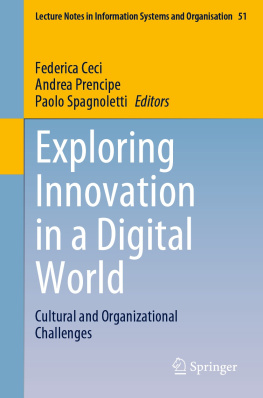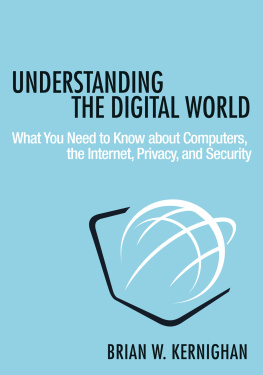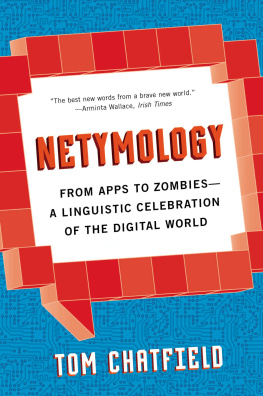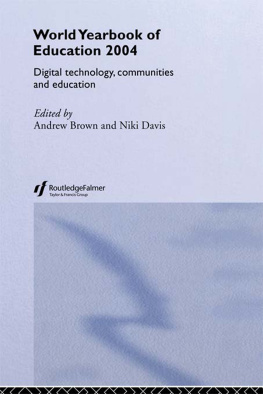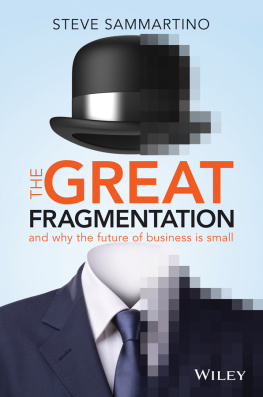digital ideas
you really need to know
Tom Chatfield

New York London
2011 by Tom Chatfield
All rights reserved. No part of this book may be reproduced in any form or by any electronic or mechanical means, including information storage and retrieval systems, without permission in writing from the publisher, except by reviewers, who may quote brief passages in a review. Scanning, uploading, and electronic distribution of this book or the facilitation of the same without the permission of the publisher is prohibited.
Please purchase only authorized electronic editions, and do not participate in or encourage electronic piracy of copyrighted materials. Your support of the authors rights is appreciated.
Any member of educational institutions wishing to photocopy part or all of the work for classroom use or anthology should send inquiries to Permissions c/o Quercus Publishing Inc., 31 West 57th Street, 6th Floor, New York, NY 10019, or to .
ISBN 978-1-62365-181-7
Distributed in the United States and Canada by Random House Publisher Services
c/o Random House, 1745 Broadway
New York, NY 10019
www.quercus.com
Introduction
What do we mean by digital? In one sense, we simply mean something whose ultimate existence is a string of ones and zeroes. A digital object, unlike the analogue stuff of the world or even of early computing, is a binary pattern.
Out of this simple fact have come some of the most transforming cultural forces of the second half of the 20th century and, now, the first half of the 21st. For perhaps the most remarkable property of digital objectswhether their ones and zeroes encode words, music, images, applications, web browsers, or databases containing much of the store of human knowledgeis their compatibility with each other.
For the first time in human history, it is possible almost endlessly to copy and distribute words, sounds, images, ideas; and it is possible to access, adapt and create all of these on the same devices.
The history of digital ideas goes back to well before the 20th century. It is in part the millennia-old story of mathematics, as well as the story of centuries of ingenious mechanical design preceding the last centurys developments in the fields of electronics and computing.
I have chosen here, however, to focus on the more recent pastand on those aspects of the digital present that seem most powerfully to be shaping our future. As a result, this is overwhelmingly a book written about and around the internet.
As I write these words, in 2011, around two billion peoplealmost one third of humanity and one half of the planets adult populationhave some form of access to the internet. Thanks to the spread of mobile internet access, this figure will continue to soar over the coming decade, as will the use of those online services steadily reshaping much of what it means to be a member of a modern society.
The news is not all good: growth, amelioration and freedom are not to be taken for granted, and indeed are not enjoyed by many of the worlds digital citizens. The internet is as powerful a force in the hands of many of the worlds repressive and censorious regimes as it is in the hands of those using it to liberate, educate, connect and delight.
Similarly, it is a breeding ground for the best and the worst of humanity alike: the scammers and the selfless; the entertainers and the mockers; the entrepreneurs and the predators. But this only makes understanding its history, structures, potentials and possible futures all the more vital.
The internet
The internet is best thought of not so much as a technology as an infrastructure: a mass of interlinked hardware and softwarefrom deep sea cables and telephone wires to desktop computers and mobile phonesconnecting an increasingly large proportion of the worlds computing devices. Many services operate via the internetincluding, perhaps most famously, the world wide webbut the internet itself predates these. It is the vast, physical network within which much of modern digital culture exists.
The history of the internet dates back to the Cold War and the communications networks developed by America in the wake of Russias launch of the satellite Sputnikthe first man-made object ever to orbit the earthin 1957. Shocked by its rivals achievement, America poured resources into developing new communications technologies. In particular, the aim was to develop communications networks able to function even if a disaster destroyed large parts of the network itself.
This early research culminated in a 1968 report entitled Resource Sharing Computer Networks, which laid the foundations for the first computer network based on a system known as packet switchingwhere all data transmitted between machines is broken down into small blocks or packets. The first computer network built using this technology was called the ARPANET (Advanced Research Projects Agency Network), and began operations in 1969, initially connecting four sites at the University of California in Los Angeles, the Stanford Research Institute, the University of California in Santa Barbara and the University of Utah.
ARPANET grew rapidly. By 1970 it had reached the east coast of America. The first ever piece of electronic mail was sent across it in 1971. By September 1973, 40 machines across America were connected to the network, and the first method for transferring computer files between themknown simply as File Transfer Protocol or FTPhad been implemented. In December 1974, the word internet itself was used for the first time in a paper by Vinton Cerf, Yogen Dalal and Carl Sunshine, as an abbreviation for the term internetworking. It referred to what was becoming a revolutionary idea: a global communications meta-network, itself formed by combining multiple networks of machines that used the same protocol for sharing packets of information. This network of networks idea is perhaps the core idea behind the modern internet.
The internet is becoming the town square for the global village of tomorrow.
Bill Gates
Protocols Cerf, Dalal and Sunshines 1974 paper formulated two ideas that would be central to the future of the internet: Internet Protocol (IP) and Transmission Control Protocol (TCP). Between them, these protocols explained the precise way in which data should be broken down into packets and sent between computers. Any computer that used these methodsusually abbreviated to TCP/IPshould, in theory, be able to communicate with any other computer also using them. Internet protocol defined the route that the data should travel along to connect computers at particular locationsor IP addresses as they would come to be knownwhile transmission control protocol ensured that the packets of data were sent in a reliable, ordered manner.
IPv6
Since 1981, every computing device attached to the internet has had a unique numerical address allocation to it via the fourth version of the Internet Protocol system on which the net is based: IPv4 for short. Today, however, the phenomenal growth in internet-based resources means that IPv4 is running out of numbers. IPv4 is able to support only 4,294,967,296 unique internet addressesthe maximum size of a 32-digit binary number. The newest, sixth version of Internet Protocol is based on 128-digit binary numbers, allowing more than a billion times as many addresses again as version four. Switching the internet over to a new protocol is a huge challenge, especially for older physical hardware, and it is being performed and tested in several stages. But it is an increasingly urgent task, with address exhaustion for IPv4 dated for some regions to mid-2011.



